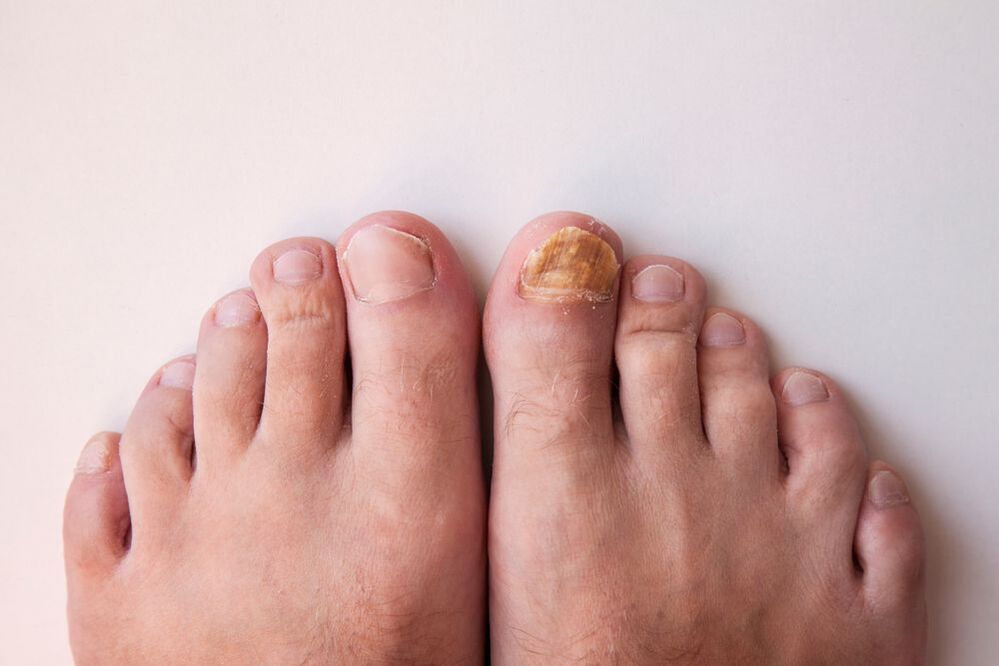Fungus (ringworm) on the feet– fungal infections of the skin of the feet and interdigital folds, nails, caused by pathogenic and conditionally pathogenic fungi. Conditional pathogens are natural inhabitants that are present in the normal microflora of the skin and mucous membranes in small quantities, however, under certain conditions, fungi begin to acquire pathogenic (disease-causing) properties and cause diseases. Regardless of the pathogen, the disease has similar symptoms and treatment tactics.

In 9 out of 10 cases, the cause of mycoses on the legs is fungi of the genus Trichophyton. According to statistics, men are more likely than women to develop a fungal infection on the skin of their feet. Men represent almost 58% of all cases. Nail fungus (onychomycosis) most often develops on the III-IV nail plates of the feet. Often, long-term untreated nail fungus becomes the cause of foot mycosis and vice versa. It should be noted that some non-fungal skin diseases can be complicated by the appearance of a fungal disease. Often, foot eczema is associated with mycoses.
Foot fungus symptoms

Dermatophytosis of the feet
Dermatophytosis of the feet (Tinea Pedis - athlete's foot) is the most common mycosis of the skin of the feet and nails. Fungal process of the feet, as a rule,begins with damage to the side surfaces. Scaly peeling (peeling) of the skin may occur. This process is not always accompanied by discomfort, itching or pain.
Over time, hyperkeratosis develops -thickening of the skin. Sometimes you may notice a slight redness on the skin, accompanied byflour peeling, giving the skin a "powdered appearance". The skin becomes dry, and itching and pain may occur. If a fungal infection is not treated at this stage, after a while, diaper rash will appear in the interdigital spaces. Most often, the interdigital form of the foot fungus affects the folds between the third and fourth, fourth and fifth toes. Skin defects can form, characterized by a violation of its integrity (erosion) and painful cracks. In the interdigital (intertriginous) form, pronounced manifestations of itching and sometimes burning appear on the affected skin.
INneglected formfungal disease of the feet occurs with the formation on the surface of the toesbubblesfilled with a clear liquid and covered by a thick stratum corneum. "Sago grains" (bubbles) can be single or merge into multi-chambered bubbles. As pyococci (purulent bacteria) gather, the contents of the blisters become cloudy, then they open and erosions are formed, covered with purulent hemorrhagic crusts. Inflammation of the lymph nodes and deterioration in general health are possible.
When blisters appear, it is important not to confuse a fungal infection with dyshidrotic eczema. Only a doctor can understand the problem and diagnose it accurately! In 2/3 of patients with interdigital and advanced forms of tinea pedis, mycidae (allergic skin rash) are observed.
Of course, the identification of clinical forms is conditional, since their combination often occurs - one form can transform into another. It all depends on the body's reaction, physical activity and the patient's treatment methods.
Furthermore, in foot mycosis, the nails are often affected, especially on the first and fifth toes. The nail plate acquires yellowish spots or stripes, the surface becomes dull and uneven, and a horny thickening begins to appear under the nail, which subsequently leads to the destruction of the nail plate.
Yeast-like foot mycoses
Recently, fungal infections of the feet caused by fungi of the genus Candida have become widespread. It is assumed that this is due to the widespread use of antibiotics and cytostatics (antitumor drugs).
Mushroomsgenus Candida, settling in the interdigital folds, causes symptoms similar to abrasion and diaper rash on the skin. Often, all interdigital spaces are involved in the cutaneous process. There is pain and burning in the skin between the toes. Nail candidiasis (candida fungus infection) is more common on the hands of women - housewives, laundresses, laundresses, food distributors in canteens. The nail plates become loose, peel off and white spots appear.
Foot fungus mold
Fungal mycoses are common mainly in countries where people traditionally walk barefoot (India, African countries). In regions with a temperate climate, this type of mycosis also occurs, but, as a rule, in patients with immunodeficiency and in people who frequently come into contact with soil and plants. The color of the nail plate will depend on the type of specific pathogen. The nail plate may even turn black.
However, when painting the nail in this way, it is important not to miss the malignant form of the finger skin tumor -subungual melanoma.It is essential to consult a doctor to obtain a correct diagnosis!Often, fungal changes in the skin of the feet and nails can occur simultaneously. On the one hand, this can serve as confirmation of a general fungal nature, on the other hand, it can mask other skin problems.
A change in the color or thickness of the nail plate is not always necessarily onychomycosis (nail fungus). Nails can be damaged by injuries, wearing tight shoes, poor quality nail polish or bacterial infection. For example, the nail plate acquires a green color due to Pseudomonas aeruginosa infection. Even so, colors such as yellowish-brown, gray, whitish should suggest a fungus and the need for laboratory diagnosis. Furthermore, the thickness of nails with fungal infection may remain normal or, on the contrary, become very thin.
Causes of foot fungus
The main reasons for the development of fungal infections on the feet are:
- Increased sweating of the feet.
- Presence of chronic diseases.Diabetes mellitus, certain blood diseases, prolonged use of antibiotics or immunosuppressant medications (immunosuppressants) contribute to the development of a fungal infection and the spread of the disease to other parts of the body.
- Presence of microtraumas in the legs.Small cracks and cuts are a direct path to infection. Therefore, it is very important to immediately treat damaged areas of the skin with antiseptic agents.
- Failure to comply with hygiene rules.Walking barefoot in public places (baths, saunas, swimming pools) can cause fungal infections.
Cream to treat foot fungus
Thanks to its special chemical structure, the medicine has a triple effect on fungi: it helps to suppress their growth, reproduction and death, as well as blocking the transition of fungi to the pathogenic form. Sertaconazole also has good lipophilicity (ability to dissolve in the fatty structures of cells). This ensures rapid and effective penetration of the medicine into the skin and increases the local antifungal effect. At the same time, the development of resistance of the fungal infection to treatment is practically not observed. The drug has an antibacterial effect against streptococci and staphylococci, relieves itching and inflammation.
Thus, the advantages of creams are:
- Broad spectrum of antifungal action
- Triple effect on fungal cells
- Reduction of itching, inflammation and antibacterial effect
- Good penetration into affected areas of the skin and long-lasting antifungal effect due to lipophilicity
- May be used during pregnancy and breastfeeding if the expected benefit to the mother outweighs the possible risks to the fetus
The medicine has an antibacterial effect against streptococci and staphylococci, relieves itching and inflammation
Application of creams
For fungal infections of the feet, it is recommended to apply the product in a thin layer to the affected area of the skin, covering 1 cm of healthy skin 1 to 2 times a day for 2 to 4 weeks. They have a triple effect: antifungal, antipruritic, anti-inflammatory
Preventing foot fungus
To prevent fungal infections of the feet and nails, you should follow the following preventive measures:
- Disinfect shoes during foot fungus treatment
- Maintain personal hygiene, do not walk barefoot in public places (swimming pools, saunas, baths)
- Don't wear other people's shoes
- Choose shoes according to the season and preferably from natural materials.
- Treat fresh wounds and cuts immediately
- Use products to reduce sweating on your feet
Answers to questions
Is it possible to get reinfected by the fungus?
To respond:Yes you can. Previous fungal skin diseases do not cause lasting immunity. Therefore, you can be infected by the fungus an unlimited number of times.
What is better to use to treat fungus: pills or creams and ointments?
To respond:The treatment regimen is determined exclusively by the attending physician. This takes into account the severity and degree of the fungal infection. As a rule, fungal infections of the feet and nail plates are treated with local (external) agents.























